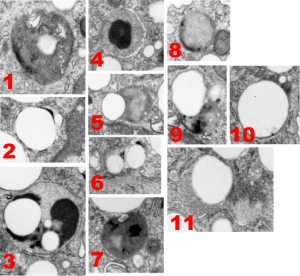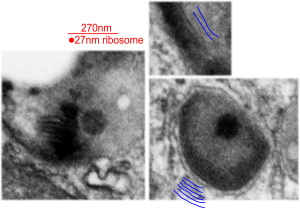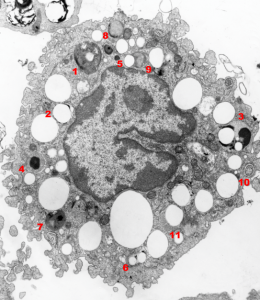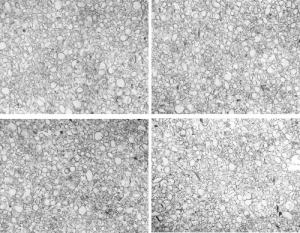I have seen these… at the present moment I am looking over the published literature for Weibel Palade bodies (WPD) in order to determine if there is ever a place where ribosomes are present on the bounding membrane. So far, none. This makes this cell adjesion group of molecules, while oligomerized into very beautiful structures, some like tubules, they are quite different from the intracellular granule purported to be a surfactant protein (possible SP-A) found in the cytoplasm of alveolar type II cells in the lungs of some species… which have a very precise localization and number of ribosomes on their limiting membrane (opposite sides of the long dimension of the granule, and approximately 4 ribosomes per 100nm).
| Weibel-Palade Bodies (WPB) | Layered granules in alveolar type II cells |
| At least 12 different proteins are found in granules | Undetermined number of proteins in type II cell granules |
| Recovered as oligomers in clathrin coated vesicles | Recovered, but not recycled or re-internalized as oligomers |
| Granules as single membrane bound SMOOTH ER | Granules as single membrane bound with end to end distribution of ribosomes, |
| Interacts with cell elements in blood | Interacts with fluid elements in alveolar space |
| Endothelial cell product | Epithelial cell product |
| Interacts with white cells and platelets | Interacts with alveolar macrophages |
| VWP apparently oligomerizes to influence the shame of WPBs | Oligomerization of the SPs involved in intracisternal bodes of alveolar type II cells create the granuel shape |
| WPBs maybe storage (albeit a small percent of total) for VWP | Granules in type II cells maybe for surfactant protein storage |
| WPBs have P-selectin in small quantitites, i wonder if these are for binding of clathrin proteins to initiate recycling from the secretion bubble structures after exocytosis of VWP? | Re-uptake, recycling of surfactant proteins is not so obvious (but happens) not big obvious vesicles… at least not that I have seen. |



